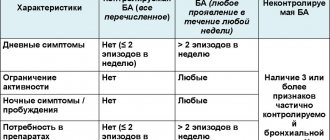Spirometry for bronchial asthma: goals, implementation, results
Bronchial asthma is a common disease. About 5-10% of the world's population suffers from this pathology. Diagnosis of the disease is a complex multi-stage process.
Spirometry prescribed to patients with bronchial asthma is an important diagnostic test. It allows you to study the ventilation function of the lungs in asthmatics.
Spirometry is prescribed to definitively clarify the diagnosis and determine the severity of bronchial asthma.
What is spirometry
Spirometry is a study that allows you to study the tidal volume of the lungs using a special device. It is used to measure the volume of exhaled air. Moreover, the analysis is carried out both at rest, when breathing should be normal, and under load.
Spirometry is considered a safe and painless procedure. At the same time, it is a highly effective method for assessing respiratory function.
After completing the examination, the doctor receives a number of data, having studied which, it is possible to determine not only the type of pathology, but also the degree of damage to the lungs.
Spirometry for diagnosing bronchial asthma
During diagnosis, the patient is often prescribed spirometry; it is effective for identifying pathologies of the respiratory tract and bronchial asthma. The procedure itself is completely painless and does not cause any serious inconvenience to the patient.
Initially, an examination of a patient suspected of having asthma is carried out according to the standard procedure indicated for all patients with respiratory disorders. Then an additional test with bronchodilators is done.
In conclusion, in addition to the general results of spirography, the type of bronchial asthma and the most suitable bronchodilator drug are indicated.
The study of spirometry indicators obtained during examination of a patient with suspected bronchial asthma makes it possible not only to determine the cause of bronchial obstruction, but also the degree of damage.
Spirometry is prescribed:
- At initial diagnosis.
- When choosing an effective treatment.
- To control the course of the disease. For mild to moderate illness, it is enough to be examined once a year; for severe illness, at least once every 6 months.
What can be assessed using spirometry
Not all patients diagnosed with bronchial asthma understand the need for spirography. Meanwhile, this is a very important diagnostic study.
When performing it, using a special device, you can estimate the volume of exhaled air. New generation devices also determine its composition during inhalation and exhalation. This allows you to evaluate the efficiency of gas exchange in the lungs.
Recording is carried out in several modes: free breathing, under load, after taking medications, and so on. At the same time, a number of important indicators are recorded.
In the background the following are evaluated:
- Tidal volume (VT). This indicator shows the volume of inhaled and exhaled air. The study is carried out in a calm state. The patient is advised to sit.
- Respiratory rate per minute (RR).
- Minute respiration volume (MRV).
- Vital capacity of the lungs (VC).
After this, a number of studies are carried out to assess the external respiratory function of a patient suffering from bronchial asthma.
The main indicators that are measured during forced inhalation and exhalation include:
- FEV1. This is the volume of exhalation produced with effort in the first second.
- FVC Fixed vital capacity.
- Tiffno index. In the case of bronchial asthma, this indicator must be calculated. It is calculated by the ratio of vital capacity to FVC.
- The maximum speed of exhalation made with effort.
All these indicators are usually assessed as percentages, and the state of functioning of normal, healthy lungs is taken as 100%.
At the third stage, the patient is given bronchodilators, mainly short-acting, and the testing is repeated.
In some cases, provocative tests may be performed. For example, histamine is used for this. At the same time, the reaction of the bronchi is assessed.
This test is used when diagnosing the disease is difficult. This is the most dangerous stage of the study, and it is prescribed in exceptional cases. During this procedure, constant monitoring of the patient's condition is required.
Indications and contraindications for the study
Spirography prescribed for bronchial asthma, like almost any diagnostic method, has its indications and contraindications. The study is recommended and carried out if:
- the patient often experiences pressing pain localized in the chest area;
- the patient has a long history of smoking;
- for 3-4 weeks the patient is tormented by an incessant cough;
- there is a suspicion of pulmonary obstruction;
- there are problems with airway patency;
- attacks of bronchial asthma have become more frequent than usual;
- if there is a risk of hereditary predisposition to the pathology;
- the patient complains of shortness of breath;
- working conditions are associated with contact with allergens.
Despite the fact that the procedure is considered safe, not all patients can undergo it. Spirography is not recommended if the following conditions and pathologies are present:
- any chronic disease in the acute stage;
- high blood pressure;
- angina pectoris;
- hypertensive crisis;
- heart attack;
- problems with blood circulation;
- pulmonary failure;
- toxicosis during pregnancy.
Spirography is recommended to be performed when the patient is at least 6 years old. It is at this age that control of inhalation and exhalation can already be ensured.
Before the procedure, consultation with the attending physician is required. For example, if the doctor thinks the test may trigger an asthma attack, he or she may recommend another diagnostic test.
Preparation rules
For the examination, the patient must not eat for several hours. The optimal time for diagnosis is morning.
The day before the study, it is recommended to avoid taking any medications that have bronchodilator properties.
The patient is required to stop smoking 6 hours before the procedure. Tea and coffee are not recommended on the day of the study.
The procedure itself takes at least 10 minutes. Moreover, before testing begins, the patient must be given time to calm down and bring his breathing back to normal.
If the patient is using an inhaler, it is important to remember to take it with them.
Dizziness may occur during spirography. This condition in itself is not dangerous. An exercise test can trigger an asthma attack.
How the research is carried out
The correct actions of the staff and the patient during a spirogram for bronchial asthma allow you to obtain the most accurate result.
If all the doctor’s requirements are met, the procedure does not cause any unpleasant emotions or sensations in the patient. It is important to ensure that the patient does not experience anxiety or agitation during operation of the spirometer.
The main purpose of the study is to assess the working volume of the lungs. In this case, it is necessary to exclude or confirm the presence of certain pathological processes.
To obtain the most accurate result, the procedure is carried out in a dimly lit room. It is advisable to exclude loud sounds and other irritating factors. Recommended air temperature is from 18 to 24C.
During the study, different models of devices are used to measure breathing parameters, ranging from a purely mechanical device to a modern computer spirometer.
The study is carried out according to the following methodology:
- A patient suffering from bronchial asthma needs to be seated. Carrying out the examination while standing can greatly distort the main indicators of spirography, which will be significantly higher than normal.
- A special clip is placed on the patient's nose.
- The patient is given a special sterile mouthpiece. Several calm inhalations and exhalations are performed through it.
- After this, a series of inhalations and exhalations is performed with maximum amplitude.
- Pause 20 seconds.
- Inhale and exhale again at a normal pace.
- The last breathing cycle is performed at the maximum possible pace.
If necessary, the doctor may ask the patient to take as deep breaths as possible for 20 seconds.
The whole procedure takes no more than 15 minutes. After this, the patient needs to rest for some time.
Additionally, a test with bronchodilators may be prescribed. In this case, there are a number of differences from the standard procedure.
At first, everything is done as in a normal study. The patient is then given a bronchodilator, most often by inhalation. After a short period of time, the procedure is repeated.
This study allows you to choose the right medicine that has the greatest therapeutic effect. It is also possible to identify spasms in the bronchi and understand whether the obstruction processes are reversible.
Decoding the results
When performing spirometry, the following indicators are assessed, which are important in the diagnosis of bronchial asthma:
- Respiration rate is an important indicator. At rest, a normal adult should have no more than 16-18 respiratory cycles per minute. In children this figure is significantly higher. In bronchial asthma, RR also increases.
- Tidal volume. This value shows how much air (volume) a person's lungs can hold in one breath. For men this value is higher.
- Minute breathing volume. This is the total volume of air passing through the patient's lungs within one minute. Values from 4 to 10 liters are considered standard.
- Forced vital capacity of the lungs. To measure this indicator, the patient first needs to inhale as deeply as possible, and then exhale as deeply as possible.
- Forced expiratory volume per second. The indicator depends on the age and gender of the subject. In this case, it is estimated how much air the patient can exhale in the first second.
- Tiffno index. Allows you to assess the patency of the lungs.
If the patient has bronchial asthma, then spirometry will reveal deviations in certain indicators.
When deciphering a spirogram for bronchial asthma, the following parameters are taken into account:
- patient's gender;
- age;
- height;
- weight.
They should be taken into account, since some indicators are characterized by a large range of acceptable limits. What is normal for one person may be pathological for another.
Finally
Spirometry is the fundamental diagnostic method used [M33] for bronchial asthma.
The procedure, which is fairly harmless and painless for the patient, allows not only to identify the pathology itself, but also to determine the severity of the disease.
However, the study also has contraindications. Before undergoing it, you need to get a prescription from your doctor.
Source: https://bronchialnaya-astma.com/diagnostika/provedenie-spirometrii
What is spirometry or spirography
Types of spirometry tests:
- breathing at rest;
- forced expiration (Tiffno);
- maximum ventilation of the lungs;
- provocative tests using drugs.
All air measurements are carried out using a spirometer - a small portable device that records 26 modes and parameters of external respiration. The device has a numeric keypad for entering the patient's date of birth, height, and weight. A tube is attached to the device, into which the patient breathes at the doctor’s command. After the measurements are taken, a sheet is printed on which the test results and a graphical representation of the dynamics of breathing are indicated.
Bronchial asthma is one of the most common pathologies. It affects men, women and children of all ages. Without high-quality diagnostics, effective therapy is impossible.
A spirogram for exogenous, endogenous and mixed bronchial asthma is almost always carried out. This is a very popular and simple diagnostic method that allows you to study external respiration functions (REF). With its help you can:
- detect obstructive disorders;
- monitor ventilation disorders;
- control the disease;
- establish the effect of the bronchi on loads;
- evaluate the effectiveness of the treatment;
- confirm reversibility and variability of obstruction;
- detect pulmonary or heart failure.
For humans, such a diagnosis does not pose any danger. There is no interference in the body, but a load is created on the respiratory apparatus, which can lead to a deterioration in the patient’s condition.
The study can be carried out not only for diagnosis, but also for monitoring pathology. Respiration readings are recorded in the form of a spirogram graph.
Attention! There are contraindications: exacerbation of asthma, hemoptysis and pneumothorax, rehabilitation period after surgery on the eyes or abdomen, airborne infections, myocardial infarction, toxicosis.
Spirography for allergic, infectious, aspirin, occupational, nocturnal and other bronchial asthma is allowed for patients of different ages. For children under four years of age, such diagnostics are rarely prescribed. This is due to the restlessness of children, due to which the information obtained during the study turns out to be unreliable.
Normal spirometry bronchial asthma
Spirometry is a safe, affordable and highly informative way to study the ventilation function of the lungs. This diagnostic method allows not only to detect disturbances in the functioning of the respiratory system, but also to determine their nature.
Spirometry for bronchial asthma helps confirm the presence and degree of bronchial obstruction.
How is the research conducted?
To carry out such a procedure, a special medical device is required. A conventional mechanical spirograph is represented by a movable cylinder, which is immersed in a vessel with water and connected to a recording device.
When a patient breathes into an empty cylinder, its volume changes - this is how the change in lung volume during breathing is recorded. Today, computer spirometry is more often used.
This diagnostic method allows not only to measure basic spirometric values, but also to determine additional values in order to create a more complete picture of the disease and diagnose pathology in the early stages.
The surrounding environment affects the patient’s well-being, and therefore the results of the study.
The procedure is carried out in an isolated, quiet, dimly lit room with an air temperature of 18 to 24 degrees and optimal humidity.
Clothes (tight collar, tie, trouser belt, bra) should not interfere with the breathing process. It is extremely important to perform breathing movements exactly as the doctor asks.
If it is necessary to obtain spirometry results during the basal metabolic rate, then the following rules must be observed:
- come early in the morning;
- do not eat before the test;
- Do not take medications during the day before the procedure (as recommended by your doctor).
An hour before the procedure, it is advisable to rest lying down. If there is enough data, with relative rest, spirometry is carried out during the day, 2 to 3 hours after a light meal. Before the procedure you need to sit for 15 - 30 minutes.
Standard spirometric values
Spirometry makes it possible to measure lung volumes during normal and very active motor movements. Using these results, it is possible to calculate pulmonary capacities and other indicators, the size of which changes during broncho-obstruction.
Lung volume has several components.
Vital capacity (VC) is one of the most important spirometric values. To measure it, after a series of normal inhalations and exhalations, you need to take the strongest breath and exhale just as deeply.
Lung capacity includes other values:
- inspiratory capacity (Evd);
- functional residual capacity (FRC);
- total lung capacity (TLC).
During the study, forced vital capacity (FVC) is also determined. In bronchial asthma, these data are especially important, since they reflect the strength of bronchial obstruction. To determine FVC, the patient must take a deep breath and then quickly exhale. In addition, the forced test allows you to determine the following characteristics:
- forced expiratory volume per second (FEV1);
- Tiffno index;
- maximum expiratory volumetric flow rate at 25%, 50% and 70% of FVC;
- average expiratory volumetric flow rate at the level of 25-75% of FVC;
- peak expiratory volume flow (PEF).
First of all, the general appearance of the spirogram is assessed. Externally, it looks like a curved line on graph paper, different segments of which correspond to certain values. If there are any deviations, the graph greatly changes its appearance.
Modern devices themselves analyze the results obtained and build not only a standard spirogram, but also a “flow-volume” curve. On the graph, it has a teardrop shape with a beveled right side.
In the case of bronchial asthma, this part of the loop ceases to be smooth and “sags”.
Decoding the received data
Interpretation of the results allows you to monitor the course of asthma, determine the stage of the disease, assess how effective the therapy is, and make a prognosis.
Indicators of pulmonary volumes and pulmonary capacities can vary significantly in men, women, children and the elderly, patients with different types of chest cells (normasthenic, hypersthenic and asthenic) and different levels of fitness.
In addition, the result is influenced by atmospheric pressure and body position. With bronchial obstruction, the following changes are observed on the spirogram:
- decreased vital capacity (often indicates a severe course);
- decrease in ROvyd;
- decrease in FEV1;
- decrease in Tiffno index;
- reduction of SOS25-75%;
- decrease in POSvyd;
- normal or increased FRC;
- increase in TOL.
The proper values with which the obtained indicators are usually compared are as follows:
- Vital vital capacity not less than 90;
- FEV1 not less than 85;
- Tiffno index not less than 70;
- OOL – from 90 to 110;
- the ratio of OEL to OEL is not more than 105.
The earliest and most reliable sign of bronchial obstruction is a decrease in the calculated average volumetric velocity at the level of 25-75% of FVC.
However, calculating this value requires very precise measurements, so usually only computer spirometry makes it possible to find out this indicator.
Thus, a decrease in values associated with exhalation and an increase in values associated with inhalation are clearly visible. This is due to the difficulty of air passing through the narrowed lumen of the bronchi.
Based on the results obtained from such a study alone, one cannot speak with confidence about bronchial asthma. This diagnostic method allows you to detect the presence of bronchial obstruction - narrowing of the lumen of the bronchi.
This pathology is observed not only in asthma, but also in chronic obstructive pulmonary disease, bronchitis, bronchiolitis obliterans, and tuberculosis.
In this regard, to make a final diagnosis, it is necessary to conduct other studies: chest x-ray, sputum analysis, blood tests.
source
Carrying out spirometry for bronchial asthma and interpreting the results
Bronchial asthma is a common disease. About 5-10% of the world's population suffers from this pathology. Diagnosis of the disease is a complex multi-stage process.
Source: https://hpt-kld.ru/normalnaya-spirometriya-bronchialnaya-astma/
Normal indicators
The results of the study will be within normal limits if the person does not suffer from bronchial asthma. 500-600 milliliters is the tidal volume when the patient has not previously performed physical activity, 1500 milliliters is vital capacity. 90-95 percent of simple lung volume is forced vital capacity (FVC).
The following values are also set.
- The amount of air that enters the body in one minute is the total volume of air that passes through the body while a person is inactive.
- The amount of forced exhalation - within one second, a patient who does not suffer from asthma exhales at least 1050 ml. A reduction in this value confirms that the patency of the respiratory system has worsened.
The Tiffno index is also installed. This indicator is determined as follows: the value of the volume of forced air is divided by the value of vital capacity. A value of 70–75 percent is considered normal.
Carrying out spirography for bronchial asthma
Bronchial asthma affects 5 to 10% of people in the world.
This pathology is characterized by increased reactivity of the bronchial tree and narrowing of the lumen of the bronchi, which subsequently causes cough, shortness of breath and other characteristic manifestations.
It is not easy to assess the severity of the process without special equipment, so the use of spirography for bronchial asthma is a key point in the diagnosis of this disease.
What is spirography?
Spirography is the process of recording tidal volume using a special device. It is used to determine the respiratory function of the lungs, both during normal breathing movements and during special exercises. The examination is painless and does not take much time.
At the end of the procedure, the doctor receives a number of indicators, based on which he describes the quality of ventilation and draws conclusions about the presence of any violations.
Indications for spirography
The following factors may be indications:
- attacks of breathlessness that occur suddenly during daily activities, at night or during physical exertion;
- dry cough for more than a month that does not go away after taking medications;
- pain or feeling of pressure in the sternum;
- shortness of breath, a feeling of shortness of breath and inability to take a full breath;
- shallow breathing accompanied by prolonged exhalation;
- changes in breathing upon contact with specific allergens.
In asthmatics, the above symptoms can occur both together and separately with varying degrees of severity. At first they may appear only at night and for a short time, but subsequently progress. It is necessary to consult a doctor in the early stages of the disease in order to conduct the necessary research.
Types of spirography during bronchial asthma
A spirogram for bronchial asthma is needed to assess the effectiveness of the treatment. One of the main goals in the treatment of this disease is to achieve normal pulmonary function.
Asthma is characterized by differences in the diameter of the bronchi, which can change spontaneously or depending on treatment. These changes are clearly visible in the results of spirometry if it is performed several times.
A feature of spirography in patients with bronchial asthma is the need to identify the relationship between the disease and bronchospasm. To do this, before the study, the patient may be required to perform a small physical activity, for example, perform 10-15 squats.
To determine the most appropriate medication, a “control” test may first be performed, after which the patient is given a medication aerosol (bronchodilator). After 10-15 minutes the test is repeated. The study may be carried out several times until a drug is found that best suits the patient.
How often can I do it?
Since this procedure does not carry any risks for the body, there are no restrictions for its implementation. It is recommended to do spirography after the start of treatment, after 3-6 months and then periodically for control purposes.
The use of a bronchodilator is part of the diagnosis process and should only be used initially. A positive result indicates the presence of bronchospasm and reversibility of obstruction.
However, this reversibility may not always be noticed the first time, which may require repeated testing with Salbutamol.
Source: https://allergiya03.com/diagnostika/spirografiya-pri-bronchialnoy-astme.html
Indications and contraindications for the procedure
The interpretation of the spirogram is carried out taking into account the personal characteristics of the patient (gender, age, weight, height). The norms for patients who belong to different groups are not the same. Without taking this fact into account, it will not be possible to establish the correct cause of the disease. The list of indicators that were obtained when reviewing the results includes:
- the amount of air entering the body per minute;
- breathing density;
- vital capacity of the lungs;
- tidal volume.
These indicators are established at the very beginning of the procedure. For the purpose of a more in-depth study of the functioning of the lungs, additional studies are prescribed.
To establish the reactivity of the bronchi, provocative tests are done. The test is also indicated in the following cases:
- the clinical picture is unclear;
- have chronic diseases;
- the etiology of the disease is unknown.
Attention! Provocative tests are taken under the supervision of a doctor.
Spirometry for bronchial asthma: indicators, interpretation
Spirometry for bronchial asthma is prescribed to obtain basic data on external respiratory functions. It is also performed to monitor the development of the disease and evaluate the prescribed treatment. For chronic respiratory diseases, examination is recommended at least once a year.
Indications and contraindications
During the examination, various diseases of the respiratory system are identified, as well as their consequences for health. The technique is used if the patient constantly coughs and suffers from shortness of breath. FVD measurement is also indicated for bronchospasms, difficulty inhaling and exhaling.
It is also recommended to be examined before bronchoscopy and thoracotomy. The test helps confirm the diagnosis if the doctor suspects the patient has developed:
- obstructive bronchitis and other pathologies of the bronchi and lungs, characterized by a sluggish course;
- bronchial asthma;
- allergic lesions of the respiratory tract;
- sarcoidosis;
- chronic obstructive pulmonary disease.
FVD can also be measured at home. There are special devices for this. Periodic testing is recommended for smokers, children who are often sick, allergy sufferers, and people after tuberculosis has been cured.
Spirometry is also performed for bronchiectasis. It is carried out for all types of dilation of the lumen of the bronchi every year or more often. In this case, obstructive ventilation disorders are usually detected. A third of patients suffer from bronchial hyperreactivity.
Spirometry for asthma is prescribed by a pulmonologist. Such ventilation tests are quite simple, so they can be performed on patients of any age. But in some cases the study is postponed or cancelled:
- In the acute course of the disease, when inhalation and exhalation are accompanied by a strong cough. This makes spirometry difficult, so the examination is performed when relief occurs.
- When air or gases accumulate in the pleural cavity.
- For some forms of tuberculosis.
- If bleeding occurs in the respiratory system, an infection occurs, or a tumor develops.
- With aortic dissection.
- In the postoperative period until complete recovery. The procedure is not performed if the chest or abdominal cavity or visual organs were operated on.
The doctor can authorize or prohibit the study after assessing the patient’s condition. Arterial hypertension can also serve as a contraindication.
Conducting research for bronchial asthma
The procedure does not require special preparation, but some rules must be followed:
- Stop smoking for five hours before spirometry.
- Reduce the intensity of physical activity during the day.
- Do not eat food for two hours before the test.
- Do not take drugs that have the ability to dilate the bronchi. For how long you need to exclude it, and what medications your doctor will tell you.
If the patient cannot do without medications, then the results are interpreted taking into account the treatment.
The day before visiting the doctor, you should avoid drinks that contain caffeine. Before entering the office, you need to loosen your tie and belt, as well as other items that make breathing difficult. Half an hour before the session you need to rest and calm down, and also remove lipstick.
Pulmonary function is measured using mechanical or portable spirometers. The whole procedure will take no more than 20 minutes and is carried out as follows:
- The patient sits on a chair and straightens his back as much as possible.
- A clip is placed on the nose and a disposable mouthpiece is placed in the mouth. It is connected to the device tube.
- First, the person takes a deep breath.
- After this, the doctor gives commands, and the patient must follow them. He holds his breath and exhales quickly or smoothly.
When using simple spirometers, information will be shown on a scale or pressure gauge. Modern equipment allows you to display data on a display screen or print it out.
If a coughing attack begins during the measurement, the examination is stopped until breathing returns to normal.
The studies are performed three times with short breaks. The results are assessed based on the best indicators.
If the patient is being examined to evaluate the effectiveness of the drug, then the drug is given between attempts.
Latent bronchospasm is determined by spirometry using drug tests. Bronchodilators like Salbutamol are suitable for these purposes.
Interpretation of spirometry results for bronchial asthma
The indicators will be as follows:
- FEV1 or the volume of air formed per second. It is measured in liters and is checked by exhaling quickly and completely after a deep inhalation.
- FVC or forced vital capacity.
In normal conditions, the ratio of FEV1 and FVC should be above 0.75. In children, the figure sometimes reaches 0.90. If the results are lower, it indicates that airflow is limited.
PEF during spirometry is determined with a portable device. The patient exhales into it as quickly and completely as possible. Peak expiratory flow is assessed using three consecutive values.
If the patient has bronchial asthma:
- the PEF value will improve by more than 20% or less than 60 l/min after inhalation with fast-acting bronchodilators;
- per day, the indicator varies and there will be a difference of more than 20% between morning and evening values.
Symptoms of the disease often appear under the influence of allergens, so skin tests and enzyme-linked immunosorbent blood tests can be performed during diagnosis.
It is difficult to identify pathology in a child under 5 years of age and an elderly person. In children, the disease should be suspected if bronchopulmonary infections recur frequently. In old age, asthma attacks are similar to symptoms of heart failure.
Where to make and price
Spirometry indicators for bronchial asthma can be determined in public clinics with a fully equipped functional diagnostics department. You can also contact research institutions and medical centers. The cost of the examination ranges from 1100-2300 rubles.
Are there alternative methods
Spirometry plays a crucial role in the diagnosis of the disease. Also, to determine the maximum exit velocity, peak flowmetry is performed. At home it is carried out using a portable peak flow meter. To detect infections and other damage to the respiratory organs, they resort to radiography and computed tomography.
How to prepare for spirography
Before performing spirography, you should rest a little, spend about half an hour at rest to allow your breathing to normalize. In order for the research results to be reliable, the following rules must be adhered to:
- It is better to do spirometry on an empty stomach. Usually this procedure is carried out in the morning. However, a small, light breakfast is allowed, but no later than 2 hours before spirography.
- In the morning before the examination, you should not drink strong tea or coffee.
- You should refrain from smoking several hours before spirometry.
- Some time before the procedure, the doctor may stop medications so that the assessment of respiratory function is objective. An exception is spirometry with a bronchodilator for bronchial asthma. In this case, the effectiveness of the drug is assessed.
- You should not wear tight or uncomfortable clothing that restricts breathing. It is better to undergo the examination in loose clothing.
Before the procedure, the doctor will find out from the patient whether there are any contraindications. You need to tell your doctor about any chronic diseases you have and the medications you are taking for treatment.










